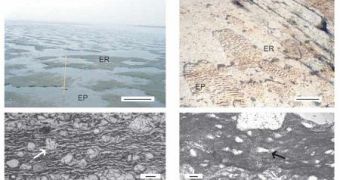For a long time, biologists have been drawing attention to the massive similarities that exist between certain ecosystems on our planet and regions of Mars, or even other terrestrial exoplanets. They are hypothesizing that, if life exists on Earth, or at least traces of it endure, then it may not be too much to assume that the same holds true for other places as well. This also makes sense when considering the fact that geological evidence indicates a water-rich past for Mars. It is well known that the existence of liquid water can boost the chances of life developing several times over, Space reports.
Old Dominion University geobiologist Nora Noffke says that she discovered signs of life in the most unlikely places on Earth, during the course of her career. Both modern and ancient, now-fossilized coastal areas revealed a massive number of clues pointing to the wonderful species that lived at the locations thousands or millions of years ago. She reveals that this is especially true for beaches, which have been known to be covered in bacterial mats. Trillions of bacteria create a blanket of sorts over the sand, and remain fossilized there over the ages. The traces can now be easily identified.
Noffke reveals that the oldest such signs date back to more than 3.2 billion years ago, here on Earth. Given that estimates place the last streams of liquid water on Mars some one billion years ago, that leaves a lot of leeway for investigations into Mars' past. The expert also believes that geology and biology combined have a great chance of finding life on other worlds. She reveals that she has been working with colleague Sherry Cady of Portland State University in creating models of life on Mars.
The team has been studying cyanobacteria, which are basic organisms of the photoautotrophs genre. This means that they rely on photosynthesis to get their energy, and do not require other nutrients. These bacteria can live absolutely anywhere there is sunlight, so it may not be far-fetched to believe that, if they once developed in Martian water, they could have endured until now. They can live basically anywhere. They can grow directly on pure, sterile sand. They don't need any soil. They gather all they need from the atmosphere and sunlight, Noffke says.
The two experts are currently working with other researchers on compiling a database of all the signatures that life leaves behind when it becomes fossilized. These indexes, once completed, will be used by space exploration crews and machines to figure out if any such signs exist on other planets they are visiting.

 14 DAY TRIAL //
14 DAY TRIAL //